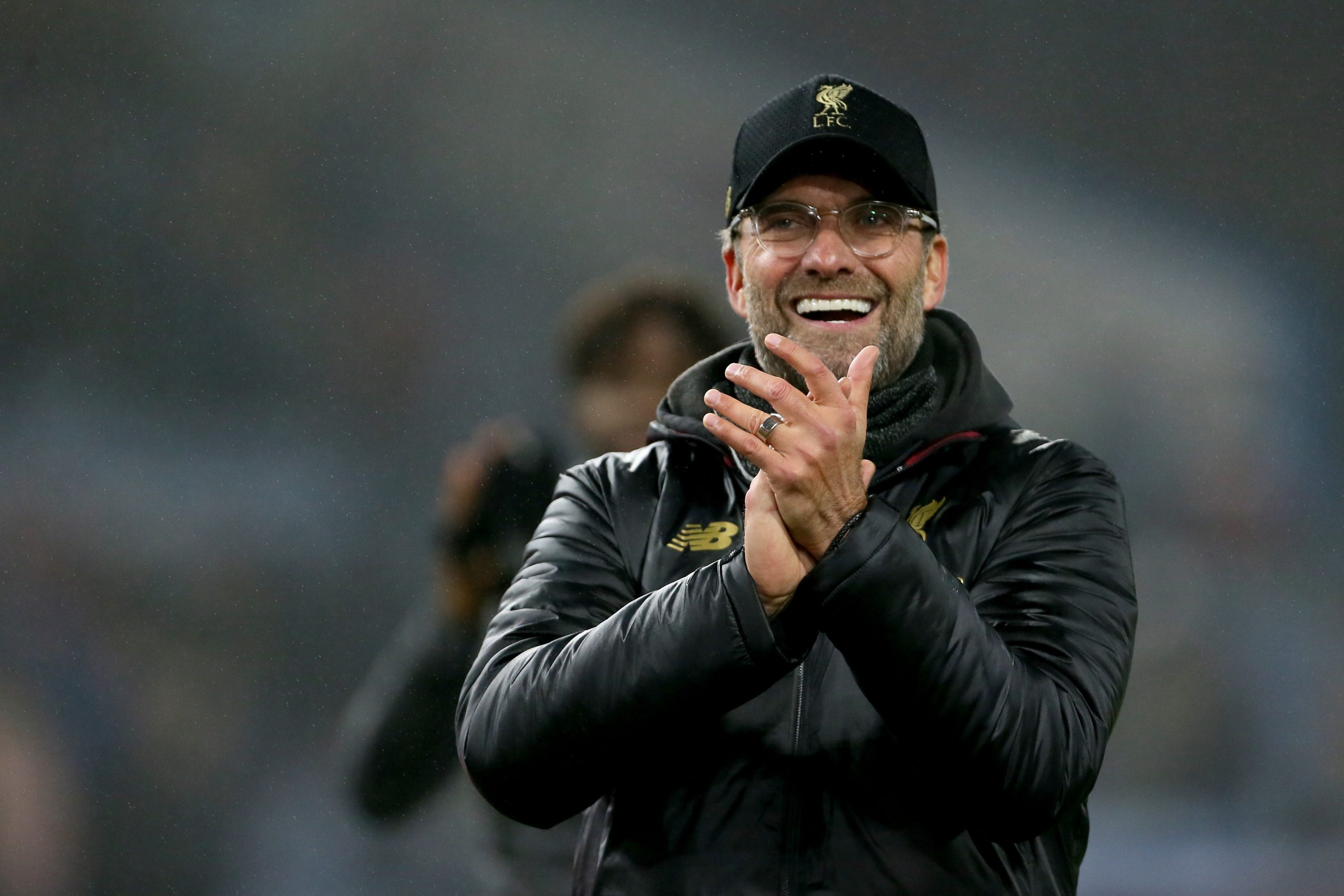For a manager so associated with a particular style of football, Liverpool’s tactical evolution under Jürgen Klopp has been surprisingly complex. There has already been much discussion about the extent to which Liverpool have dropped off from the high press this season. Here at StatsBomb, Euan Dewar looked at the numbers and found mixed evidence. Nonetheless, there are tactical shifts in Klopp’s approach this season. The obvious thing to note is that the 4-3-3, a mainstay of the previous two seasons, seems to be getting phased out in favour of a 4-2-3-1 with Mohamed Salah leading the line and Roberto Firmino dropping into a number ten role. Is this a significant change in style and should it be of benefit to Liverpool? Let’s take a closer look.
Liverpool’s Football in the Klopp Era
When Klopp took over from Brendan Rodgers in October 2015, he inherited a Liverpool squad which had played a number of different formations and broader approaches over the past few years, as Rodgers generally had a flexible approach. With a hectic schedule and little coaching time available, he adopted a 4-2-3-1 that featured a lot of pressing but not much in the way of a clear idea in possession. Despite reaching a Europa League final, Liverpool in 2015/16 were not a particularly interesting side and it was not until the following preseason that Klopp was able to really instigate his style at the club. The way Klopp set up Liverpool in 2016/17 was slightly unexpected. In his time at Borussia Dortmund, Klopp adopted a very fast counter-pressing style, with a 4-2-3-1 favoured, aiming to move the ball very quickly after winning it from the opposition. The German is famous for his claim that, “no playmaker in the world can be as good as a good counter-pressing situation”, having added in the past that “the best moment to win the ball is immediately after your team just lost it. The opponent is still looking for orientation where to pass the ball. He will have taken his eyes off the game to make his tackle or interception and he will have expended energy. Both make him vulnerable”. This was certainly an aspect of Liverpool’s play, but the rapid transitions in possession generally associated with Klopp were less frequent than a more possession-based approach in attack. This was perhaps a result of personnel. The most obvious star player at his disposal was Philippe Coutinho, more of a conventional playmaker than a rapid presser. Klopp generally employed Coutinho from the left, but the Brazilian interpreted the role much as much more of a player to come towards the ball and offer a possession threat than a direct winger. Klopp admitted at the time that this was central in his tactical thinking, claiming that Liverpool “don’t have wingers, apart from Sadio [Mané], we have creative players, [so] we have to find a formation where they can bring their skills”. Further to this, in the lack of an out-and-out striking option who he liked (Christian Benteke had been exiled while Daniel Sturridge was preferred as an option off the bench), Klopp opted to use Firmino as the striker, who, along with being a key pressing trigger, was much more of an involved passer than most number nines. Adam Lallana was the other key player in terms of launching the press as the most advanced midfielder in the three, as well as performing playmaking duties almost as deputy to Coutinho in this department. Thus there was a 4-3-3 system in which all players in the final third bar Sadio Mané were looking to come towards the ball, inevitably and deliberately leading to a possession-heavy approach. That the side struggled much more in the stretches of the season where either Coutinho or Lallana was injured shows how reliant this approach was on creative passing from individuals. While most managers would respond to this problem by looking to strengthen the squad with more playmaking options, Klopp instead used the transfer window to move away from a possession approach. The biggest arrival in summer 2017 was of course Salah, who obviously had a significant impact in terms of individual quality, but also caused a shift in that Liverpool now had two wide players looking to run in behind rather than just Mané. Salah was very much a wide forward, playing high and narrow on the right and thriving from Firmino’s penchant for dropping deep. Liverpool’s shape last year is clear from this passmap (one example among many): a compact midfield three, with wingers narrower than the full backs while Salah takes up positions more advanced than Firmino. 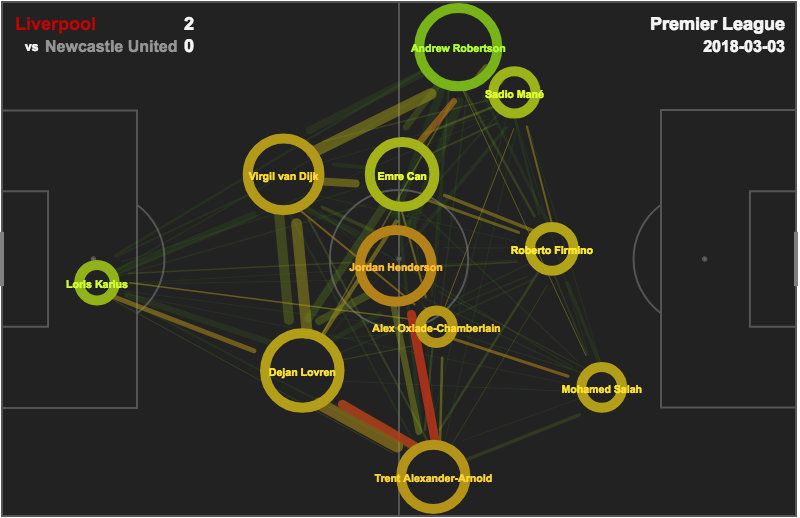 While Coutinho and Lallana were the chief playmakers in 2016/17, through transfer and injury, neither were mainstays in the side the following year. The aforementioned Salah took Coutinho’s place in the front three and interpreted the role very differently, while Lallana’s midfield role ended up largely being filled by Alex Oxlade-Chamberlain. Oxlade-Chamberlain offered different qualities, with his strongest asset perhaps being his ability to drive the ball forward from deep, exploiting space in transition. The Englishman certainly became an important cog in the way Liverpool moved the ball forward, ranking third in terms of deep progressions per 90 and second in open play passes into the box. But this personnel shift enabled a much greater emphasis on transition football, looking to attack on quick turnovers rather than prolonged periods of possession. Liverpool ranked first in the league in terms of “high press shots”, defined as shots from possessions that were won within 5 seconds of a defensive action in the opposition’s half. After the detour of something slightly different based on the tools available to him, the archetypal “Klopp football” had arrived at Anfield. So what are we seeing now?
While Coutinho and Lallana were the chief playmakers in 2016/17, through transfer and injury, neither were mainstays in the side the following year. The aforementioned Salah took Coutinho’s place in the front three and interpreted the role very differently, while Lallana’s midfield role ended up largely being filled by Alex Oxlade-Chamberlain. Oxlade-Chamberlain offered different qualities, with his strongest asset perhaps being his ability to drive the ball forward from deep, exploiting space in transition. The Englishman certainly became an important cog in the way Liverpool moved the ball forward, ranking third in terms of deep progressions per 90 and second in open play passes into the box. But this personnel shift enabled a much greater emphasis on transition football, looking to attack on quick turnovers rather than prolonged periods of possession. Liverpool ranked first in the league in terms of “high press shots”, defined as shots from possessions that were won within 5 seconds of a defensive action in the opposition’s half. After the detour of something slightly different based on the tools available to him, the archetypal “Klopp football” had arrived at Anfield. So what are we seeing now?
Liverpool’s Approach This Season
While the previous two seasons were not a failure, Klopp certainly felt the need for Liverpool to further evolve. “A lot of teams saw that we were good at that and realised they were overplaying”, Klopp told Sky Sports. “If the team gives us the opportunity to do it we will still be there with the counter-press. But very often it is not possible”. As much as a change, this feels like a continued evolution from two years ago. The side feels even less possession focused than ever, with the transitional play becoming the core of everything, especially at times springing from a slightly deeper position. The 4-2-3-1 is a part of this. With Salah moving to the striker role, the threat of pace is now coming from a central area. Though there are very few other similarities with that side, there are some similarities with the way Leicester used Jamie Vardy as the number nine in their title winning season, or the role Thierry Henry took up at Arsenal. Those teams were adept at launching fast counter attacks. The new shape can be seen in this passmap, with Salah still drifting slightly to the right but clearly ahead of a band of three attacking midfielders, backed up by Jordan Henderson and Gini Wijnaldum taking equidistant positions. 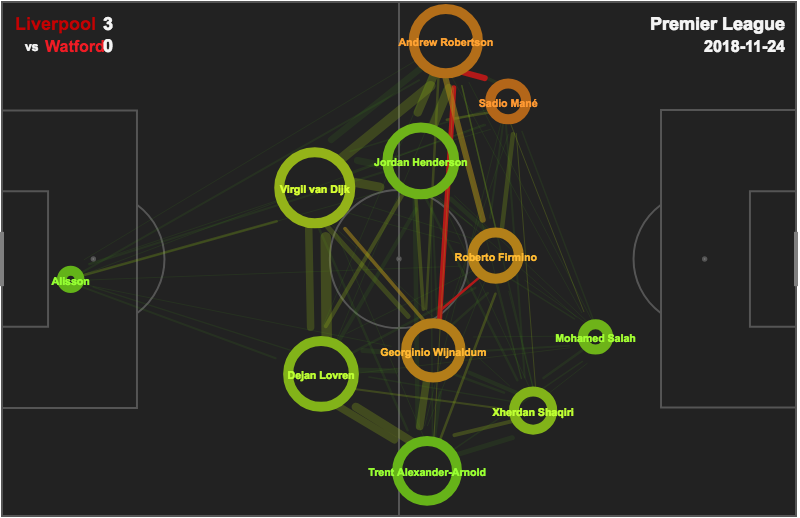 Firmino and Salah are the players who are playing the most different roles this year, and although both have received some doubts over their form at varying parts of the season, the data suggests that nothing significant has changed in their performances.
Firmino and Salah are the players who are playing the most different roles this year, and although both have received some doubts over their form at varying parts of the season, the data suggests that nothing significant has changed in their performances. 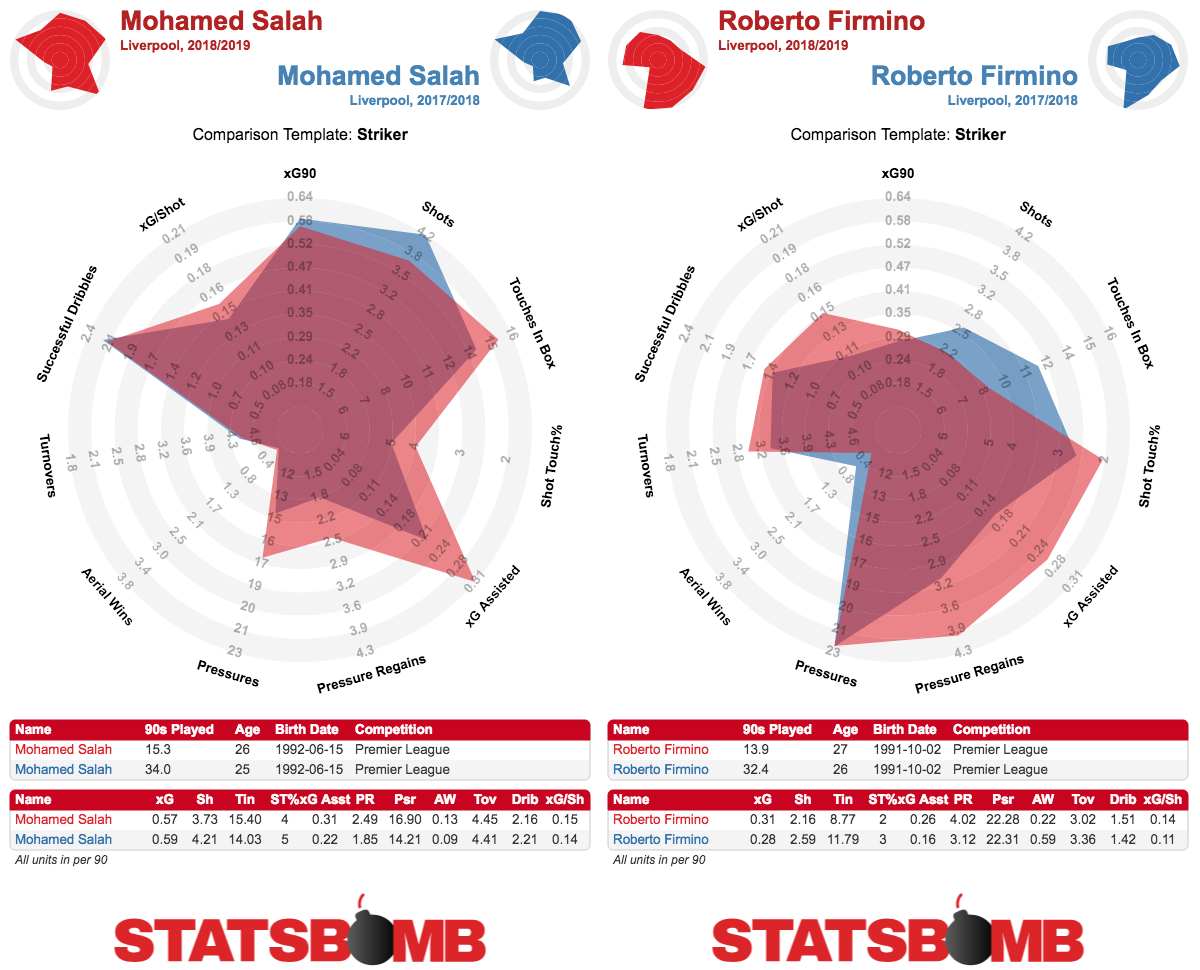 Naby Keïta and Fabinho are still being gradually integrated into the team, but it seems likely that both will eventually suit the new system. By Klopp’s own admission, a double pivot is the system Fabinho prefers to play in, and has looked uncomfortable when situated as the lone defensive midfielder. Keïta also played in a double pivot at RB Leipzig, in a side that certainly pressed, but often from a somewhat deeper block, and looked to launch fast attacks in transition. Meanwhile, the outfield signing who has thus far had the biggest impact is Xherdan Shaqiri. Playing the right sided role taken by Salah in a different system, Shaqiri has been able to thread the needle of fitting the style of play while also bringing more variety. The third goal against Burnley last week was a case of him slotting into the system well, getting on the end of a rapid counter attacking move that sums up Klopp’s approach. As noted in Liverpool’s season preview, it was a concern going into this year that the club did not have a genuine human playmaker to fit alongside Klopp’s tactical approach. While not reaching the heights of Coutinho, Shaqiri has filled this gap to a decent level, with his volume of open play passes into the box evidence of his value in Liverpool’s ball progressing.
Naby Keïta and Fabinho are still being gradually integrated into the team, but it seems likely that both will eventually suit the new system. By Klopp’s own admission, a double pivot is the system Fabinho prefers to play in, and has looked uncomfortable when situated as the lone defensive midfielder. Keïta also played in a double pivot at RB Leipzig, in a side that certainly pressed, but often from a somewhat deeper block, and looked to launch fast attacks in transition. Meanwhile, the outfield signing who has thus far had the biggest impact is Xherdan Shaqiri. Playing the right sided role taken by Salah in a different system, Shaqiri has been able to thread the needle of fitting the style of play while also bringing more variety. The third goal against Burnley last week was a case of him slotting into the system well, getting on the end of a rapid counter attacking move that sums up Klopp’s approach. As noted in Liverpool’s season preview, it was a concern going into this year that the club did not have a genuine human playmaker to fit alongside Klopp’s tactical approach. While not reaching the heights of Coutinho, Shaqiri has filled this gap to a decent level, with his volume of open play passes into the box evidence of his value in Liverpool’s ball progressing. 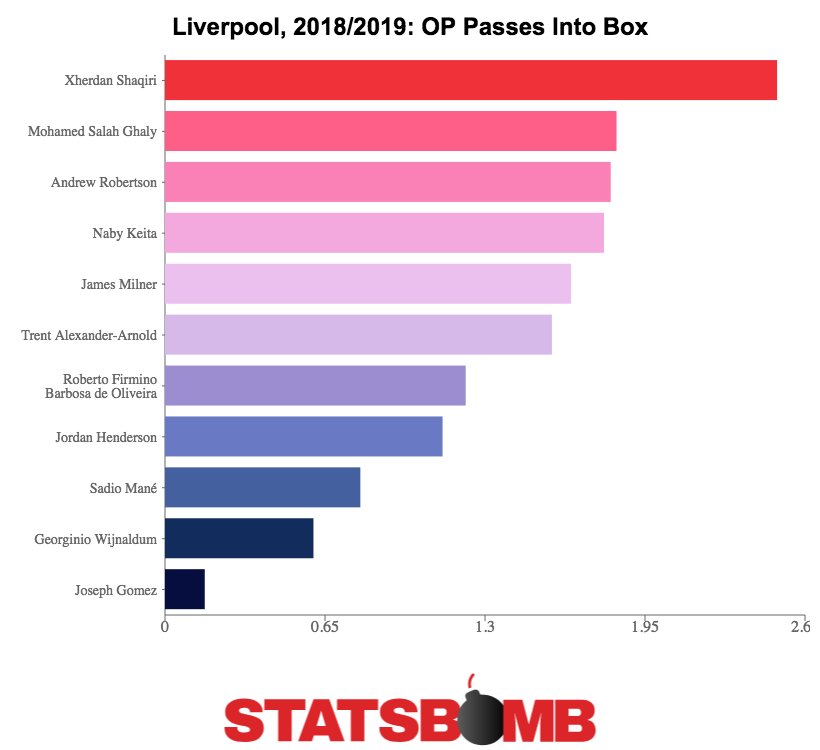 The questions when Shaqiri arrived were largely over whether he would buy into the work ethic Klopp would require of him. In that regard, his 15.06 pressures per 90 represents a middling volume, but one that is a definite step up from the 10.76 he averaged at Stoke last year, despite playing in a lower possession side with thus more frequent opportunities to press the opposition. Perhaps Shaqiri’s biggest critic, Gary Neville, claimed that he would be seen “stood on the halfway line whilst your team are being attacked”, with many of the criticisms often challenging whether he will fulfil the defensive tasks required in “big games”. This is still an open question, with the Switzerland international yet to start a game against another side from last season’s top six. Perhaps it is the point that this approach will not be so frequently used against top sides. We saw Klopp use the more familiar 4-3-3 in the win against Napoli, and this perhaps signals that said system, with its greater emphasis on pressing, might be a better option against sides that will not look to sit back against Liverpool. Alternatively, Klopp could simply be taking his time to better drill the players in the new system before being comfortable enough to use it in the hardest fixtures. Regardless, this season we are seeing yet another shift in the way he wants Liverpool to play, one that is seeing a strong return in terms of results. Eventually this team will be judged against the highest of standards in Manchester City, but even if they fall short of a title winning season, these tactical adjustments remain noteworthy.
The questions when Shaqiri arrived were largely over whether he would buy into the work ethic Klopp would require of him. In that regard, his 15.06 pressures per 90 represents a middling volume, but one that is a definite step up from the 10.76 he averaged at Stoke last year, despite playing in a lower possession side with thus more frequent opportunities to press the opposition. Perhaps Shaqiri’s biggest critic, Gary Neville, claimed that he would be seen “stood on the halfway line whilst your team are being attacked”, with many of the criticisms often challenging whether he will fulfil the defensive tasks required in “big games”. This is still an open question, with the Switzerland international yet to start a game against another side from last season’s top six. Perhaps it is the point that this approach will not be so frequently used against top sides. We saw Klopp use the more familiar 4-3-3 in the win against Napoli, and this perhaps signals that said system, with its greater emphasis on pressing, might be a better option against sides that will not look to sit back against Liverpool. Alternatively, Klopp could simply be taking his time to better drill the players in the new system before being comfortable enough to use it in the hardest fixtures. Regardless, this season we are seeing yet another shift in the way he wants Liverpool to play, one that is seeing a strong return in terms of results. Eventually this team will be judged against the highest of standards in Manchester City, but even if they fall short of a title winning season, these tactical adjustments remain noteworthy.
